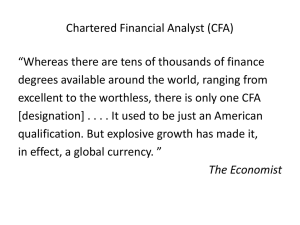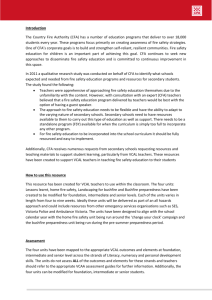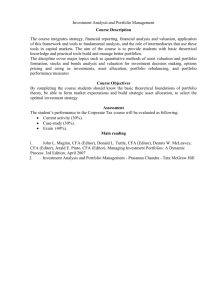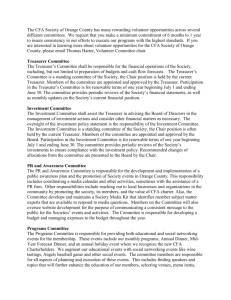The CFA and European Monetary Union
advertisement
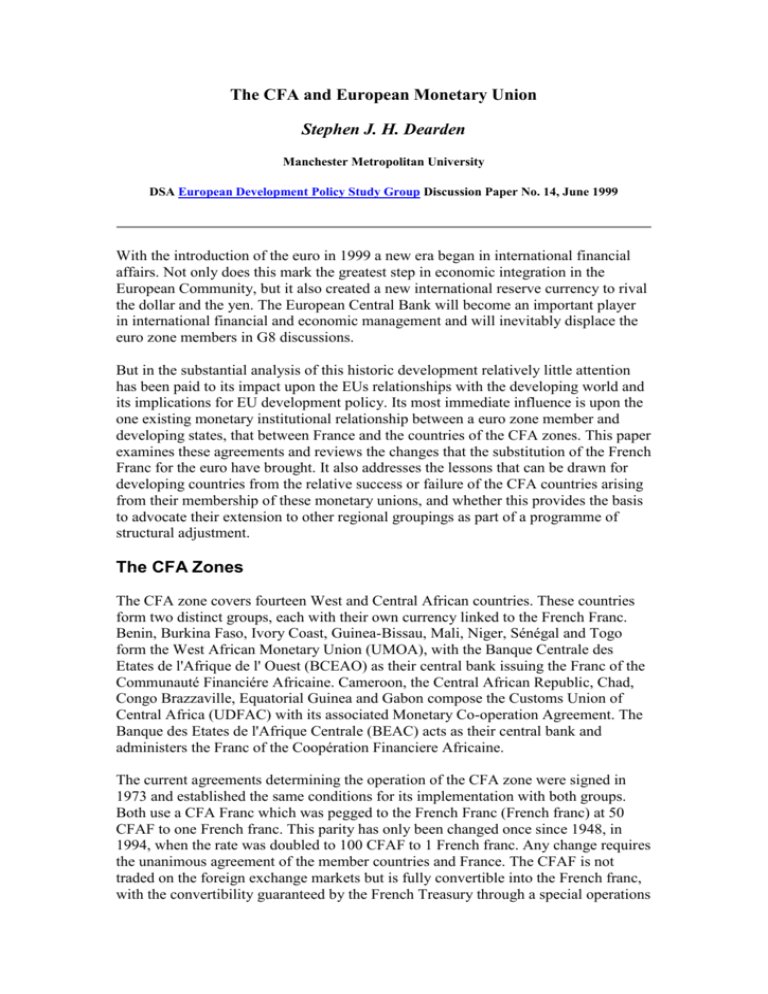
The CFA and European Monetary Union Stephen J. H. Dearden Manchester Metropolitan University DSA European Development Policy Study Group Discussion Paper No. 14, June 1999 With the introduction of the euro in 1999 a new era began in international financial affairs. Not only does this mark the greatest step in economic integration in the European Community, but it also created a new international reserve currency to rival the dollar and the yen. The European Central Bank will become an important player in international financial and economic management and will inevitably displace the euro zone members in G8 discussions. But in the substantial analysis of this historic development relatively little attention has been paid to its impact upon the EUs relationships with the developing world and its implications for EU development policy. Its most immediate influence is upon the one existing monetary institutional relationship between a euro zone member and developing states, that between France and the countries of the CFA zones. This paper examines these agreements and reviews the changes that the substitution of the French Franc for the euro have brought. It also addresses the lessons that can be drawn for developing countries from the relative success or failure of the CFA countries arising from their membership of these monetary unions, and whether this provides the basis to advocate their extension to other regional groupings as part of a programme of structural adjustment. The CFA Zones The CFA zone covers fourteen West and Central African countries. These countries form two distinct groups, each with their own currency linked to the French Franc. Benin, Burkina Faso, Ivory Coast, Guinea-Bissau, Mali, Niger, Sénégal and Togo form the West African Monetary Union (UMOA), with the Banque Centrale des Etates de l'Afrique de l' Ouest (BCEAO) as their central bank issuing the Franc of the Communauté Financiére Africaine. Cameroon, the Central African Republic, Chad, Congo Brazzaville, Equatorial Guinea and Gabon compose the Customs Union of Central Africa (UDFAC) with its associated Monetary Co-operation Agreement. The Banque des Etates de l'Afrique Centrale (BEAC) acts as their central bank and administers the Franc of the Coopération Financiere Africaine. The current agreements determining the operation of the CFA zone were signed in 1973 and established the same conditions for its implementation with both groups. Both use a CFA Franc which was pegged to the French Franc (French franc) at 50 CFAF to one French franc. This parity has only been changed once since 1948, in 1994, when the rate was doubled to 100 CFAF to 1 French franc. Any change requires the unanimous agreement of the member countries and France. The CFAF is not traded on the foreign exchange markets but is fully convertible into the French franc, with the convertibility guaranteed by the French Treasury through a special operations accounts at the Banque de France. These operations accounts can run into deficit, effectively offer unlimited overdraft facilities. This allows the CFA states to avoid short-run balance of payments constraints. In return the two CFA zone central banks are required to deposit 65% of their foreign exchange reserves in their operations accounts at the Banque de France. The French authorities participate in monetary policy formulation for the CFA zone. Each of the two zones engages in an annual monetary programming exercise that determines the individual government's credit ceiling with their Central Bank. The Central Banks also retain the power to place restrictions on the refinancing facilities available to the commercial banks and upon their ability to lend to the private sector in each state. Between the member states, and with France, there are no constraints on financial transfers. There are similar arrangements guaranteeing the convertibility, at a fixed parity, between the French Franc and the Comorian Franc. Effectiveness Although the CFA regime appeared to offer its participants a number of economic advantages during the 1960s and 1970s, contributing to an environment of price stability, concern began to emerge that the fixed parity was undermining the African states international price competitiveness. During the 1970s ten of the the CFA zone countries experienced an average annual growth rate of 4.2%, but in the 1980s this halved to only 2.3% (Assane and Pourgerami 1994). However a comparison of growth rates with other Sub-Saharan African (SSA) countries reveals a similar slowing of growth rates in the 1980s - down from 4% to 2.4%. But in regard to inflation rates the CFA countries certainly demonstrate a superior performance. Over the whole period 1970 to 1989 they averaged an inflation rate of only 7.6% per year compared with the SSA states at 16.7% per year. The first question to be addressed is how far membership of the CFA zone has assisted in the realisation of these relatively low inflation rates. Honohan (1992) established, as might be expected, a long-term relationship between CFA inflation rates and the "core" inflation rate of France. However in the short-run this core inflation rate failed to explain much of the variation in individual CFA states rates. Savvides (1998) econometric study of three CFA countries - Cameroon, the Ivory Coast and Gabon - confirmed their ability to pursue independent monetary policies, which accommodated any real depreciation in their currency arising from differential inflation rates. This arose from the nature of the operational accounts maintained by the Banque de France which, until the late 80s, provided an unlimited overdraft facility. Thus one of the major advantages of a fixed exchange rate regime - a constraint upon the rate of domestic monetary expansion - was compromised in the case of the CFA countries. Allechi and Niamkey (1994) focused upon the economic costs of meeting the reserve requirements with the Banque de France. Although the operation of the zone provided financial advantages from reserve pooling, there are offersetting costs from exchange rate risk and from differential interest rates between those offered by the Bank and world rates (eg. LIBOR). Those states with positive balances in their operational accounts and a large percentage of trade outside the CFA zone lose the most. This is the case with most of the UMOA group, where most states are net losers - especially Niger, Togo and Burkina Faso. Overall they concluded that by this criteria there were more losers than winners amongst the CFA member states. But more attention has focused upon the overall implications for economic performance of the CFA zone. Despite lower domestic inflation rates the fixed French franc parity is regarded by some critics as having been sufficient to undermine the CFA states competitiveness, with over-valuation of the CFAF reaching between 20% and 60% for the zone members by the 1980s, contributing to wage rigidity, fiscal imbalances and deteriorating economic performance. Some of the earliest work was that of Devarajan and de Melo (1987) who compared the relative growth performance of the two CFA zones with other developing countries over the period 1973-82. They established that compared with other SSA countries membership of the currency zones had been beneficial, especially over the later period 1973-82. These results were confirmed by Guillaumont et al (1988). In their study, in order to isolate the impact upon growth performance of economic policies alone, they formulated a broader growth equation for cross-sectional analysis. Deviations from the expected growth rate was then employed as the measure of growth performance. They also found an overall positive influence from CFA zone membership on growth rates, compared with other SSA states, over the years 196281, with a stronger effect in the later period 1970-81. This superior performance can be explained, in part, by the relatively limited over-valuation of their exchange rates in the 1970s (Plane 1985) and from the greater stability of both their nominal and real exchange rates between 1970 and 1983 (Paraire 1988). The result was an above average inflow of foreign capital, public savings and investment. The CFA states also sustained a higher level of exports: GDP compared with other SSAs reflecting their greater economic "openness". However Assane and Pourgerami (1994) found it difficult to replicate Guillaumont's results and in their study of the period 1970-89 were unable to establish any difference in growth rates between ten CFA countries and twenty three SSA states, although they achieved a lower inflation rate. Similarly Medhora (1990) came to a neutral conclusion, finding no evidence that membership of UMOA had imposed any economic costs. Devararjan and Roderick (1991) went further and, recognising the econometric limitations of their earlier work and the changed circumstances of the 1990s, they now found that, regardless of the method of estimation, the CFA zone members' growth performance was worse than that of comparable African countries. Over-valuation of the exchange rate was regarded as the crucial factor - a conclusion supported at the country level by Newman et al (1990) study of the Ivory Coast. Savvides (1995) supported this assessment for an even longer period. In attempting to identify the determinants of the rate of growth of African real per capita incomes, he found membership of the CFA zones had had a significant negative impact upon the growth rates of four of the nine CFA states that he examined over the years 1960-87. Interestingly in his sample of twenty eight African states he found that although inflation rates were negatively associated with growth rates, it was a relatively weak effect - ie. a 10% increase in inflation was only associated with a 0.4% reduction in growth. He is also failed to establish any adverse impact from exchange rate variability on growth rates. Both of these factors would have been anticipated to be the principle beneficial effect arising from membership of the CFA zones. The 1990s In the early 1990s growth rates in the CFA states more than halved compared with the 1980s (Table 1); although this average disguises a considerable variation in performance - ranging from Benin's 4.1% per year to Togo's -3.4% per year. Nonetheless, this performance still compares favourably with that of most other SSA countries whose growth rates fell from 2.9% per year in the 1980s to only -0.6% per year for the years 1990-95. Again, as in earlier decades, the CFA members also achieved a superior inflation performance. Between 1985 and 1995 the seven CFA countries for which data was available experienced an annual inflation rate of only 2.9%. By contrast thirteen SSA states (Botswana, Burundi, Ghana, Lesotho, Madagascar, Malawi, Mauritius, Nigeria, Rwanda, Sierra Leone, Tanzania, Zambia and Zimbabwe) averaged 27.7% per annum. The success in controlling the rate of growth of the money supply (averaging 4.3% per year) is testimony to the value of the monetary discipline imposed by membership of the zone. Table 1: CFA Zone Countries Average annual growth Average annual change in GDP deflator prices Annual nominal growth in money supply 1980-90 1990-95 1985-95 1985-95 Benin 2.6 4.1 .. 10.1 Burkino Faso 3.7 2.6 2.6 9.3 Cameroon 3.1 -1.8 2.0 -2.9 Central African Republic 1.7 1.0 3.8 6.1 Ivory Coast 0.1 0.7 4.0 2.2 Niger -1.1 0.5 1.3 1.1 Senegal 3.1 1.9 3.7 3.9 Togo 1.8 -3.4 .. 0.5 Average 1.9 0.7 2.9 4.3 Source : World Bank, World Development Report 1997 Allechi and Niamkey (1994) explained this deterioration in the CFA zone's growth rates as arising from the changes in the world economic environment. As exportorientated economies they prospered in the buoyant world economic conditions of the 1980s, especially as their competitiveness had been enhanced by the depreciation of the French franc against the US dollar. However faced with the world recession in the 1990s and the appreciation of the French franc, as the French government sought to converge with the German Deutchmark under the single currency programme, the economic performance of the CFA zone deteriorated. The lower growth rates and a deterioration in the balance of payments culminated in the 1994 devaluation of the CFAF and the adoption of structural adjustment policies in most of the CFA member states. The general improvement in these countries current account position as a consequence of these changes can be seen in Table 2, with the total CFA deficit improving from $3,395 m. in 1980 to $594 m. by 1995. It was also recognised that monetary union, unaccompanied by a common market, failed to realise the full potential economic benefits. Thus in 1994 UMOA became the West African Economic and Monetary Union (UEMOA), and in October 1996 the six members of the Central African Customs Union (UDFAC) formed the Central African Economic and Monetary Community (CEMAC). Both groups have emulated the EU with the commitment to the multilateral surveillance of economic policies as a central tenet of the Treaties. Such policy co-ordination is intended to create the conditions for macro economic stability, including budgetary discipline, and will involve both European institutions and the World Bank/IMF. Table 2: CFA Zone Countries Current Ac. Current Ac. Exports EU 1980 $ m. 1995 $ m. % Benin -36 36 46 (1989) Burkino Faso -49 15 67 (1990) Cameroon -682 -171 87 (1990) Central African Republic -43 -25 89 (1989) Ivory Coast -1826 -269 61 (1989) Niger -277 -126 82 (1990) Senegal -387 3 57 (1987) Togo -95 -57 52 (1991) Average -3395 -594 68 Sources : World Bank, World Development Report 1997; Eurostat, ACP Basic Statistics. The CFA and the Euro Whatever the advantages and disadvantages of the CFA zone for its members its future is inextricably tied to the replacement of the French Franc by the euro with the progress of European Monetary Union. On the 1 st January 1999 the euro was launched as a new currency. The eleven member countries of the euro zone irrevocably fixed their parities against the new currency and the European Central Bank took responsibility for the determination of euro zone monetary policy, including the setting of interest rates. The euro replaced national currencies in transactions between financial institutions, including the banks through the European Central Bank Clearing System (TARGET) and trades on the major euro zone equity markets. New public loans are now denominated in euros and in 2002 the euro will replace national currencies in everyday circulation. The implication for the CFA zone is the replacement of the French franc-CFA fixed parity with a euro-CFA parity. The Council of the European Community currently regards the arrangements between France and the two CFA zones and the Comoros as having no major implications for the EU as a whole. These arrangements are seen as being based upon a financial guarantee provided by the French Treasury not the Bank of France. The Bank of France, as an integral part of the European System of Central Banks, would not be able to independently offer any such guarantee of convertibility. In July 1998 the Council accepted a Commission draft proposal that laid the foundations for relations between the euro and the CFA and Comorian Francs. While providing for the continuation of the current agreements, it makes clear the responsibility of the French government and its African partners for their future implementation. The French government is however required to report to the EU's Economic and Financial Committee on any decision which has implications for the functioning of the euro zones monetary and exchange rate policies. In particular it must give prior notification of any change in the euro-CFA/Comorian parities. Any change to the CFA agreements must also be submitted and receive the approval of the Council, on the recommendation of the Commission after consultation with the European Central Bank (ECB). The major implication of the change to a euro parity for the CFA zone states lies in any possible euro exchange rate volatility. Given that some CFA countries have significant trade outside the CFA/Euro zone (Table 2) and have substantial dollardenominated debts, significant changes in the euro-dollar or euro-yen exchange rate may be of considerable importance. While a weak euro would improve their international competitiveness it would increase their debt payments. By contrast a strong euro might offer price stability, but the high interest rates associated with such a monetary policy might deter investment. Given that there is no reason to believe that the ECB will take any account of their economic requirements in determining its monetary stance it will merely be fortuitous if their monetary environment is appropriate to their individual economic conditions. However unlike members of the euro zone they do have the opportunity to devalue against the euro, as in 1994. However the adoption of such a policy option raises the same difficulties as those that haunted the EU's Exchange Rate Mechanism. Any suspicion of devaluation itself produces instability and uncertainty and undermines the monetary discipline that is intended to realise price stability, the major reward for monetary union. The introduction of the euro varied in its impact upon the two CFA groups. Although there were speculative capital flows in anticipation of a devaluation during the changeover to the euro, the West African Central Bank (BCEAO) weathered the financial storm relatively easily. By contrast the Central African bank (BEAC) had to expend a substantial part of its reserves defending the parity. This reflects the differing nature of the two groups economies and their recent economic experience. Four of the six central African countries are oil producers, with a consequent sensitivity to the dollar exchange rate. They also benefited less from the 1994 devaluation and have been less successful at structural adjustment, especially in Cameroon. For both groups the central long term issues will be the appropriateness of their parities against the euro - including the question as to whether the same euro parity should be maintained for both zones - and of the appropriateness of the euro's parity against other major world currencies. The early experience of the euro has been one of a gradual devaluation against the dollar, which has increased their international competitiveness. This has been particularly important for the West African commodity producers facing enhanced competition from East Asia, which has experienced its own substantial devaluation. However the CFA zone countries relatively low productivity growth and differential inflation rates may undermine the benefits of these parity changes in the longer term. Future Developments In January 1991 the French government introduced a 3% service charge on the convertibility of French franc into CFAF and from 1993 the CFAF was no longer convertible outside the Franc zone, seriously reducing its economic significance but also reducing the French government's financial liabilities. These developments suggest a decline in France's commitment to the CFA zones long term future. However its significance may be in the model that it provides for ACP (African, Caribbean and Pacific) regional monetary arrangements. There is no reference on the Lomé Conventions to any monetary relationship between the EU and the ACP group of developing countries. Nonetheless a wider role for the euro could be envisaged. At a minimum it may become a reserve currency for many of these states, but it could also provide the basis for the Community to pursue a proactive role in encouraging monetary integration amongst the ACPs themselves. The existing CFA zone offers the most obvious model for the development of any such policies. With the increasing possibility of the regionalisation of the EUs relationship with the ACPs, under a revised Lomé, there has been increasing emphasise upon the regional integration of the ACP states themselves. Monetary integration, following the pattern of the two CFA zones, UEMOA and CEMAC, would be expected to enhance intraregional trade through offering convertibility and currency stability. Such currency stability would also reduce the risk for foreign investment and provide a discipline for national governments monetary and fiscal policies. The EU could take a central role in encouraging the formation of such regional monetary unions, as part of its overall development policy, by establishing appropriate institutional and financial arrangements. These might initially be bi-lateral, between an ACP state and the EU, or more likely multi-lateral, as part of the establishment or development of an existing regional grouping. It might take a number of forms ranging from the provision of a bilateral stabilisation fund, with the EU offering a limited guarantee of an ACPs currency convertibility, to financial support for a full regional ACP monetary union. However it is unlikely that the EU would be prepared to match the open-ended commitment initially provided by the French government under the CFA arrangements. Nonetheless the reform and redirection of STABEX funds, which are intended to offer balance of payments support for ACP states faced with significant commodity price fluctuations, could encourage the successful development of ACP monetary relations. Short of full monetary union, a regional ACP group could establish a multi-lateral authority with powers of co-ordination and supervision to stabilise exchange rates and facilitate moves towards convertibility (Hugon 1998). Such a body could have recourse to the existing reserves of its participating states with additional financial support from the EU. Regional monetary groups would also be in a stronger position in negotiations with both the EU and with other potential economic partners. Thus UEMOA and CEMAC are, together, in a stronger position in negotiations with their dominant regional economic partner Nigeria. For any monetary union to be successful it essential that the members enter the union at appropriate exchange rates. For most ACPs inappropriate exchange rates are regarded as one of the major causes of their recent economic difficulties. Structural adjustment must include exchange rate realignment. At the same time attempting to maintain any exchange rate without appropriate domestic fiscal policies is a formula for failure. But the need for such fiscal discipline may be regarded as essential in the context of many ACPs, with their history of budget deficits and rampant inflation. The evidence from the CFA zone is that relatively low rates of inflation are achievable under such a regime. However the loss of the exchange rate policy instrument, in the context of a developing country undergoing rapid economic transformation, may prove even more problematic. Similarly the creation of significant constraints upon national fiscal as well as monetary policy, as required with monetary unions, may compromise the ability of governments to respond appropriately to their individual economic circumstances. The divergent structures of ACP economies leaves them particularly vulnerable to asymmetric shocks, compromising the ability of any multilateral monetary authority to set appropriate monetary and fiscal policies. Thus lower inflation may only be achieved at the price of lower growth and higher unemployment. While this question as to the trade-offer between inflation and growth remains unanswered a more cautious approach to any advocacy of ACP regional monetary unions would seem appropriate. Bibliography Allechi M. and M. Niamkey. 1994. Evaluating the Net Gains from the CFA Franc Zone Membership: A Differerent Perspective. World Development 22(8): pp. 11471160. Assane D. and A. Pourgerami. 1994. Monetary Co-operation and Economic Growth in Africa : Comparative Evidence from the CFA Zone Countries. Journal of Development Studies 30(2): pp.423-442. Devarajan S. and J. de Melo. 1987. Evaluating Participation in African Monetary Unions: A Statistical Analysis of the CFA Zone. World Development 15(4) Devarajin S. and D. Roderick. 1991. Do the Benefits of Fixed Exchange Rates Outweigh Their Costs? The Franc Zone on Africa. Washington: Center for Economic Policy Research. Guillaumont P. and S. Guillaumont. 1989. The Implications of European Monetary Union for African Countries. Journal of Common Market Studies 28(2) Guillaumont P., Guillaumont, S., and P. Plane. 1988. Participating in African Monetary Unions: An Alternative Evaluation. World Development 16(5): pp 569-576. Hugon P. 1998. Living With the Euro. The Courier (170): pp. 5-6. Honohan P. 1992. Price and Monetary Convergence in Currency Unions: The Franc and Rand Zones. Journal of International Money and Finance 11(4): pp 397-410. IMF. 1997. Implications for Developing and Transition Countries. World Economic Outlook, October Medhora R. 1990. The Gains from Pooling Reserves in the West African Monetary Union. Mimeo, University of Toronto. Newman J, Lavy, V and V. Vreyer. 1990. The Response of Firms to Relative Price Changes in Cote d'Ivoire: The Implications for Export Subsidies and Devaluations. Paper presented to the African Issues Conference, Nairobi. Paraire J. 1988. L'instabilité des taux de change. In: Guillaumont P. and Guillaumont S., Stratégies de développement comparées zone franc et hors zone franc. Economica. Plane P. 1985. Are Sub-Saharan Currencies Over-valued? In: Tore Rose (Ed.) Crisis and Recovery in Sub-Saharan Africa. Paris: OECD. Savvides A. 1995. Economic Growth In Africa. World Development 23(3): pp. 449458. Savvides A. 1998. Inflation and Monetary Policy in Selected West and Central African Countries. World Development 26(5): pp. 809-827.
